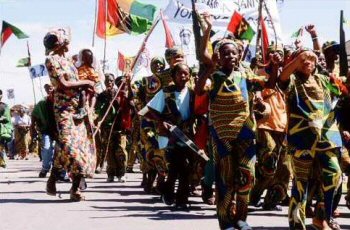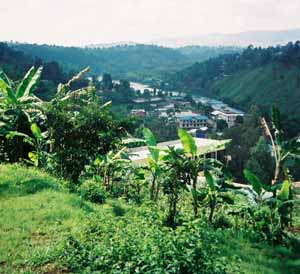PeopleEven after the genocide Rwanda's population density is among the highest in Sub-Saharan Africa. There are few villages, and almost every family lives in a self-sufficient complex on a hillside. The urban clusters are set around organized centers. The local population comprises three ethnic groups. The Hutus, who comprise the bulk of the population (85%), are farmers of Bantu origin; the Tutsis (14%) are pastoral people who came to the area in the 15th century, formed the principal caste under a feudal system founded on cattle holding; and the Twa (pygmies) (1%) are those believed to be descendants of the earliest inhabitants of the area.
|
Rwanda, often called the "Land of a Thousand Hills" is a diminutive landlocked country in the Great Lakes district of east-central Africa. Burundi, Uganda, Tanzania, and the Democratic Republic of the Congo share boundaries with this lush country of fertile and mountainous terrain. Home to almost 10 million people, Rwanda has the densest population in continental Africa. Besides the stunning natural beauty, the country is endowed with a rich flora and fauna. It also hosts some unusual species of animals, like the silverback mountain Gorillas, and many unique birds and insects in the tropical forest of Nyungwe. Rwanda is often associated with the dreadful events that unfolded in 1994 that has been imprinted into the world's awareness, as one of the most vicious genocides in history. The event is inconceivable, but the country has taken enormous strides towards healing. Today, the country is a fairly stable Central African nation, comparatively safe and accessible for travelers to roam around. |
Geography
This tiny country of Rwanda, half the size of Scotland, is situated near the center of Africa. It is divided from the Republic of the Congo by the Ruzizi River and Lake Kivu; bounded on the north by Uganda, to the east by Tanzania, and to the south by Burundi. The capital, Kigali, is located in the center of the country. Grasslands and tiny farms extending over sloping hills cover Rwanda's countryside, while rocky mountains extend southeast from a string of volcanoes in the northwest. On the western slopes of this ridgeline, the terrain slants abruptly toward the Ruzizi River valley and Lake Kivu. The eastern slopes are more restrained, with rolling hills reaching across central uplands at steadily dropping altitudes to the lakes, plains, and swamps of the eastern border district.
Famous AttractionThe Ntarama Genocide Memorial
Like the Nyamata memorial, this site was a church prior to the genocide. This serves as a memorial after thousands of people were killed within its walls. The church appearance is similar to Nyamata, with victims' clothing and remains displayed to give proof of the event. Ntarama has a serene memorial garden and wall of names at the back of the complex. Ngungwe Forest It is worthwhile to go south to Nyungwe Forest, between Cyangugu and Gikongoro. You can get guided strolls of varying length, though some require vigorous hiking! The forest is home to Colobus monkeys, chimpanzees, and many other species. Even if you fail to tcatch a glimpse of the animals, the forest is still well worth a visit. Akagera National Park Go east from Kigali to discover one of the inexpensive and unique wildlife parks of East Africa. If you arrive early in the day, you may see zebra, elephants, hippo, giraffe, baboon, and antelope, etc. It is best to explore this spot during dry season. |
HistoryThe 'Hutu Revolution' paved the way for the eviction of huge groups of Tutsis who were either displaced internally or were banished into exile. The period saw about ten intrusions by the exiled Tutsis against Rwanda
In 1990 Rwandan exiles grouped together as the Rwandan Patriotic Front (RPF) and invaded Rwanda from their base in Uganda. The rebels comprised mainly of tribal Tutsis held the government responsible for failing to resolve the problems of some 500,000 Tutsi refugees living in exile around the world. On April 6 1994 the airplane transporting the President of Burundi and President Habyarimana was shot down, as it was about to land at Kigali. Both presidents were killed, and it was a signal for the militia group to start rounding up and killing all political moderates and Tutsis regardless of their cultural background. The killing quickly spread from Kigali to all parts of the country; from April to July, genocide of unparalleled pace turned up around a million Tutsis and moderate Hutus dead caused by the brutality of the military. The international society responded with one of the biggest humanitarian assistance ever rendered. The UN peacekeeping force UNAMIR was shut down during the fighting but brought back up to vigor after the RPF triumph. The administration started the long-awaited genocide trials, which got off to an indecisive stance. The triumph or breakdown of the Rwandan social compact will be determined over the coming years as Tutsi and Hutus try to find ways to exist in harmony. It is important to note that in recent elections 56% of the Parliament seats were won by women. |
NightlifeRwanda offers a pleasurable and relaxing nightlife with several clubs and bars. Generally the ambiance is nice, very African; the music is good; the crowd is lovely; and the food is tasty and appealing.
Nightlife starts very early, all year round. The Mango Club is one nice club, with a vibrant atmosphere, set to the lively music of African contemporary tunes. The beer is cheap, and latest radio hits are played - mostly reggae classics. This place is popular with both locals and foreigners. The bigger hotels also have bars where you can relax and unwind. The bar of Hotel Milles Colines is one great place where you can delight in a nightcap. |
Culture
Kinyarwanda is the principal spoken language in Rwanda; it is also spoken in the east of Congo and in the south of Uganda. Kinyarwanda is a tonal language of the Bantu language family, closely connected to Kirundi, spoken in the adjoining country, Burundi and to Giha of western Tanzania. English and French are also official languages, and many inhabitants will speak one or the other besides the Kinyarwanda.
Most Rwandans are Christians. A survey reported that 56.5% of the population were Catholic, 37.1% Protestant (of which 11.1% are Adventists, and 14,000 Jehovah's Witnesses), 4.6% Muslim, 1.75% claimed no religious beliefs, and 0.1% practice conventional indigenous beliefs.
CuisineRwandans eat simple meals made with locally grown ingredients. The diet consists mainly of beans, sweet potatoes, fruit, peas, millet, and corn. The traditional breakfast consists of porridge and sweet potatoes. In urban districts such as Kigali, people normally have bread and tea for breakfast.
Lunch and dinner may comprise of bananas, boiled beans, cassava, or sweet potatoes. Umutsima (a dish of corn and cassava), mizuzu (fried plantains) isombe (cassava leaves with Eggplant and spinach) are regular dishes. Dinner is the heaviest meal. Between meals, Rwandans often snack on fruits: tropical fruits such as papayas, avocados, mangos and bananas are plentiful in Rwanda. |
Qunar







